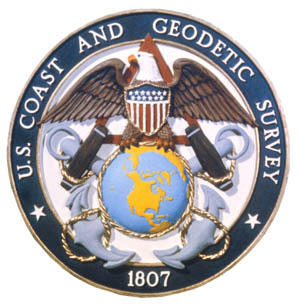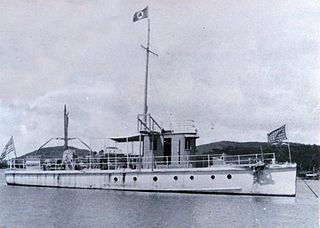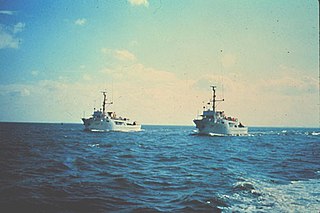
William Pope McArthur was an American naval officer and hydrologist who was involved in the first surveys of the Pacific Coast for the United States Coast Survey.

The United States Coast and Geodetic Survey, known from 1807 to 1836 as the Survey of the Coast and from 1836 until 1878 as the United States Coast Survey, was the first scientific agency of the United States Government. It existed from 1807 to 1970, and throughout its history was responsible for mapping and charting the coast of the United States, and later the coasts of U.S. territories. In 1871, it gained the additional responsibility of surveying the interior of the United States and geodesy became a more important part of its work, leading to it being renamed the U.S. Coast and Geodetic Survey in 1878.

USC&GS Carlile P. Patterson was a survey ship of the United States Coast and Geodetic Survey in operation between 1883 and 1918. Subsequently, she had a brief period of naval service and fifteen seasons as a merchant vessel before she was wrecked on the Alaska coast in 1938.

USC&GS Pioneer was a survey ship that served in the United States Coast and Geodetic Survey from 1922 to 1941. She was the first ship of the Coast and Geodetic Survey to bear the name.

USS Surveyor was an armed steamer that served in the United States Navy from 1917 to 1919. Prior to her U.S. Navy service, she operated as the survey ship USC&GS Surveyor for the United States Coast and Geodetic Survey in 1917, and she returned to that role after her U.S. Navy decommissioning, remaining in Coast and Geodetic Survey service until 1956.

NOAA Ship Surveyor was an oceanographic survey ship in commission in the National Oceanic and Atmospheric Administration (NOAA) from 1970 until 1995. Prior to her NOAA career, she was in commission in the United States Coast and Geodetic Survey from 1960 to 1970 as USC&GS Surveyor. She was the second and last Coast and Geodetic Survey ship named Surveyor and has been the only NOAA ship thus far to bear the name.

USC&GS Yukon was a schooner that served as a survey ship from 1878 to 1894 in the United States Coast Survey, which was renamed the United States Coast and Geodetic Survey in 1878. She was the pioneering Coast Survey or Coast and Geodetic Survey ship in many of the waters of the Territory of Alaska, including the Bering Sea and the western Aleutian Islands, and she also operated extensively in California and Washington. She later entered commercial service as Elwood and was wrecked in 1895.

USC&GS Yukon was a steamer that served as a survey ship in the United States Coast and Geodetic Survey from 1898 to 1923. She was the second and last Coast and Geodetic Survey ship to bear the name.

USC&GS Ranger was a steamer that served in the United States Coast and Geodetic Survey from 1919 to 1930 or 1931.

USC&GS Matchless was a wood, two masted schooner that served as a survey ship in the United States Coast and Geodetic Survey from 1885 to 1919. She was the only Coast and Geodetic Survey ship to bear the name and the last sailing vessel owned and operated by the Survey.

USC&GS Isis was a survey ship that served in the United States Coast and Geodetic Survey from 1915 to 1917 and from 1919 to 1920.

The first USC&GS Hydrographer was a survey launch that served in the United States Coast and Geodetic Survey from 1901 to 1917 and from 1919 to 1928.

USC&GS Marindin was a launch that served as a survey ship in the United States Coast and Geodetic Survey from 1919 to 1944. She was the only Coast and Geodetic Survey ship to bear the name.

The first USC&GS Discoverer was a survey ship that served in the United States Coast and Geodetic Survey from 1922 to 1941.

NOAAS Heck was a Rude-class hydrographic survey ship in the National Oceanic and Atmospheric Administration (NOAA) from 1970 to 1995. Prior to her NOAA service, she was in commission from 1967 to 1970 in the United States Coast and Geodetic Survey as USC&GS Heck.

The second USC&GS Fathomer was a steamer that served as a survey ship in the United States Coast and Geodetic Survey from 1905 to 1942.

The first USC&GS McArthur, originally USCS McArthur, was a steamer that served as a survey ship in the United States Coast Survey from 1876 to 1878 and in the United States Coast and Geodetic Survey from 1878 to 1915.

USC&GS Cosmos was a survey launch in service in the United States Coast and Geodetic Survey from 1887 to 1927.

The first USC&GSS Pathfinder, also noted in some NOAA histories as "old Pathfinder", was a United States Coast and Geodetic Survey ship in service from 1899 to 1941, when she was beached in sinking condition on January 30, 1942, after 40 years service in the Philippines.




















